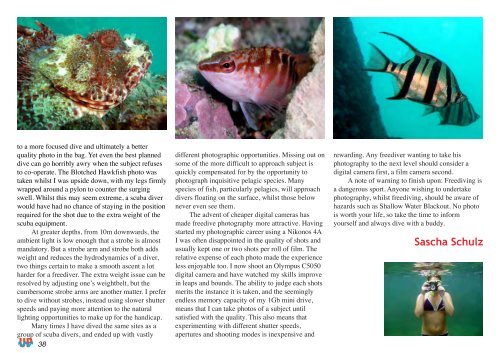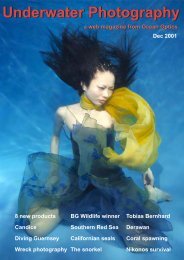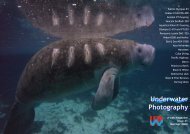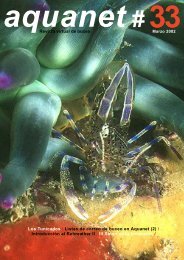Underwater Photography - SENSACIONES.org
Underwater Photography - SENSACIONES.org
Underwater Photography - SENSACIONES.org
Create successful ePaper yourself
Turn your PDF publications into a flip-book with our unique Google optimized e-Paper software.
to a more focused dive and ultimately a better<br />
quality photo in the bag. Yet even the best planned<br />
dive can go horribly awry when the subject refuses<br />
to co-operate. The Blotched Hawkfish photo was<br />
taken whilst I was upside down, with my legs firmly<br />
wrapped around a pylon to counter the surging<br />
swell. Whilst this may seem extreme, a scuba diver<br />
would have had no chance of staying in the position<br />
required for the shot due to the extra weight of the<br />
scuba equipment.<br />
At greater depths, from 10m downwards, the<br />
ambient light is low enough that a strobe is almost<br />
mandatory. But a strobe arm and strobe both adds<br />
weight and reduces the hydrodynamics of a diver,<br />
two things certain to make a smooth ascent a lot<br />
harder for a freediver. The extra weight issue can be<br />
resolved by adjusting one’s weightbelt, but the<br />
cumbersome strobe arms are another matter. I prefer<br />
to dive without strobes, instead using slower shutter<br />
speeds and paying more attention to the natural<br />
lighting opportunities to make up for the handicap.<br />
Many times I have dived the same sites as a<br />
group of scuba divers, and ended up with vastly<br />
38<br />
different photographic opportunities. Missing out on<br />
some of the more difficult to approach subject is<br />
quickly compensated for by the opportunity to<br />
photograph inquisitive pelagic species. Many<br />
species of fish, particularly pelagics, will approach<br />
divers floating on the surface, whilst those below<br />
never even see them.<br />
The advent of cheaper digital cameras has<br />
made freedive photography more attractive. Having<br />
started my photographic career using a Nikonos 4A<br />
I was often disappointed in the quality of shots and<br />
usually kept one or two shots per roll of film. The<br />
relative expense of each photo made the experience<br />
less enjoyable too. I now shoot an Olympus C5050<br />
digital camera and have watched my skills improve<br />
in leaps and bounds. The ability to judge each shots<br />
merits the instance it is taken, and the seemingly<br />
endless memory capacity of my 1Gb mini drive,<br />
means that I can take photos of a subject until<br />
satisfied with the quality. This also means that<br />
experimenting with different shutter speeds,<br />
apertures and shooting modes is inexpensive and<br />
rewarding. Any freediver wanting to take his<br />
photography to the next level should consider a<br />
digital camera first, a film camera second.<br />
A note of warning to finish upon: Freediving is<br />
a dangerous sport. Anyone wishing to undertake<br />
photography, whilst freediving, should be aware of<br />
hazards such as Shallow Water Blackout. No photo<br />
is worth your life, so take the time to inform<br />
yourself and always dive with a buddy.<br />
Sascha Schulz
















